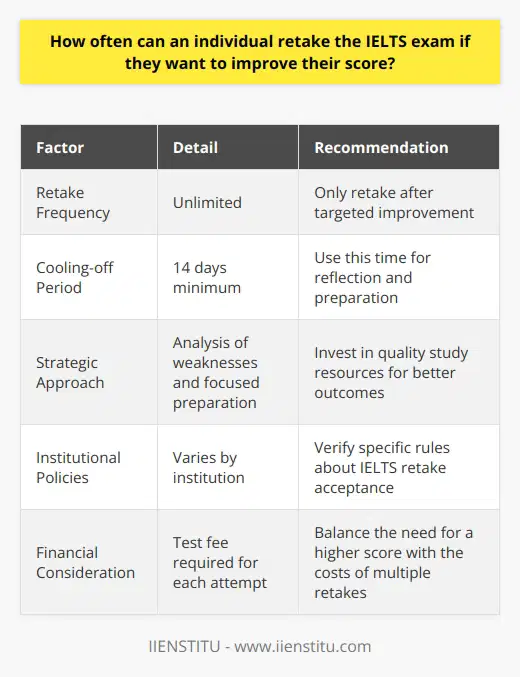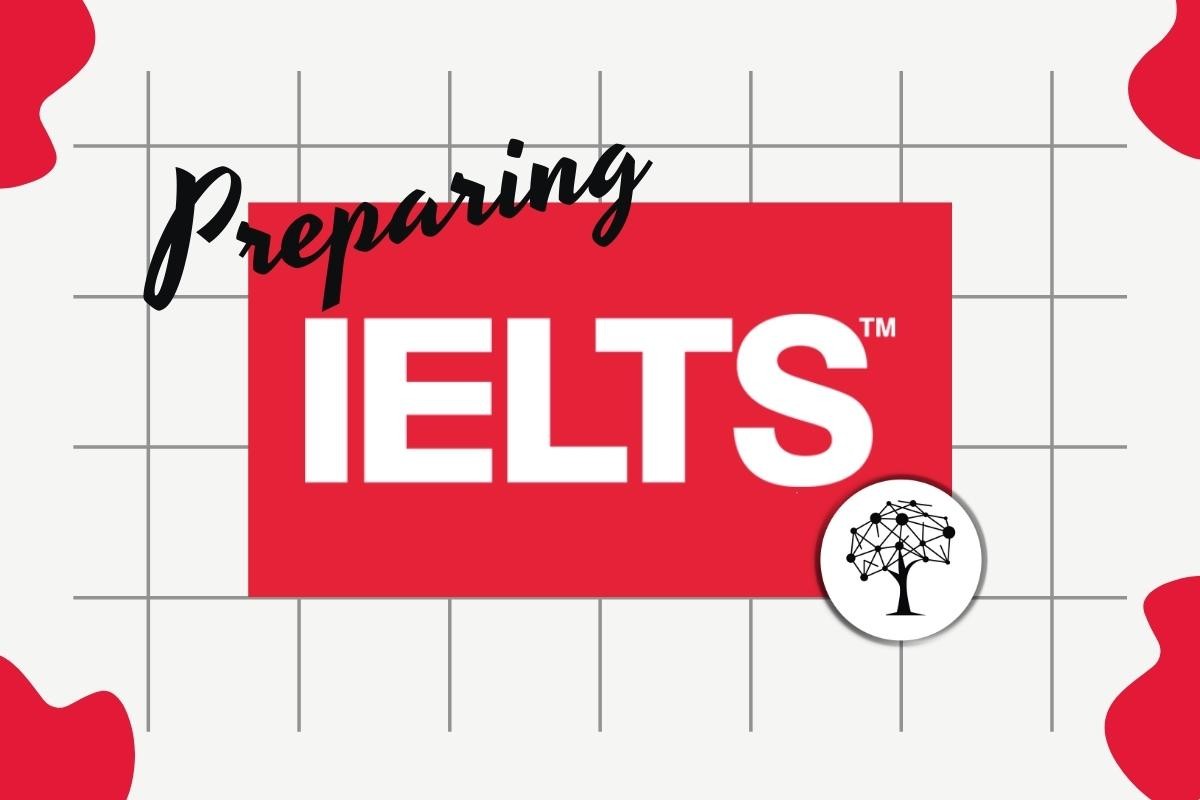
The IELTS test is an internationally recognized entrance requirement for higher education institutions worldwide. The exam mainly consists of reading comprehension, writing, and speaking skills, which students need to be familiar with to enter courses at their chosen universities without any difficulties whatsoever! Nowadays, it's harder than ever to get into university because of many students. The IELTS test is designed to ensure that everyone who wants to study abroad has an equal chance, no matter where they are from or what language they speak.
Students can take the IELTS test in more than 150 countries, with more than 2 million tests being sat across the world each year. The IELTS test is jointly managed by Cambridge English Language Assessment, the British Council, and IDP Education Australia. Many different types of students take the IELTS test to get into university. They vary from school leavers to adult professionals looking for more education to change careers. Some people also take the IELTS test while still in high school because it is a requirement for certain countries' universities. In some cases, the IELTS test scores can even be used to get into secondary school.
The IELTS test has four sections: reading, writing, listening and speaking. All four are meant to test students' English language abilities in different areas, so they are graded equally.
The Format Of The IELTS Test
The reading section of the IELTS test is split up into three question types: multiple-choice, gap fill, and matching. In this section, students need to read various texts and answer questions based on what they have read. There are many different questions in this section, so it helps students become familiar with a range of vocabulary and writing styles. This section is worth 40 out of the total test mark.
The writing section of the IELTS test has two question types: independent writing and integrated writing. Students have to write a letter or an email based on a given situation in the particular question type. The integrated task type requires students to write a few paragraphs for an essay about an exciting event from their own lives. In both cases, they need to do research first before writing their pieces using the new vocabulary and phrases that they have learned. This section is worth 40 out of the total test mark.
The listening section of the IELTS test asks students to answer true or false, multiple-choice, and short answer questions. They will need to listen carefully to a series of people talking about an exciting event or topic, then select the correct answer to the questions. There are two sections in this section, which gives students 20 out of the total test mark.
The speaking section is one of the most complicated parts of the IELTS test! Students need to participate in a conversation with another person about an exciting event or topic, then talk about it for two minutes. They are also asked to summarize the issues after listening to another person. This section is worth 20 out of the total test mark.
The IELTS test scoring system considers both content and language, so students do not need perfect English or extensive vocabulary knowledge. Instead, the tests focus on what students can do with the language they know.
IELTS sınav puanlama sistemi hem içeriği hem de dili dikkate alır, bu nedenle öğrencilerin mükemmel İngilizceye veya kapsamlı kelime bilgisine ihtiyacı yoktur. Testler, öğrencilerin bildikleri dille neler yapabileceğine odaklanır.
Educational institutions will only recognize the IELTS test in countries where it is used, so it doesn't matter which country you take the test in! This makes it easier for international students to get into university as local students do.
The IELTS test is an excellent way for students who don't have perfect English to get into university, as it proves they will be able to do the work required. It also opens up opportunities for students who want to study abroad or access other educational programs. Finally, for anyone thinking about going back to school, the IELTS test can't be beaten because it's the best way to build their way into university!
What Are IELTS Strategies?
Common strategies that can help improve your score on the IELTS:
When it comes to doing well on tests like the IELTS, some plans will be of great help. If you think more of your system as a tool rather than an approach, it can make more difference. For example, writing small notes in the margins of your textbook will be more helpful than writing extended essays in a notebook because it'll allow you to test yourself.
Make sure that practice tests are part of your study plan. If you want an overall idea of how well you're doing, taking timed tests can help. In addition, it's essential to determine which areas you need to focus on and improve.
The common mistakes in the Speaking and writing sections of the IELTS people can be improved by understanding what is required in these sections. For example, when it comes to the spoken exam, your chance of scoring more will increase with every extra minute you have to talk. Also, if you revise before speaking, you'll have a better idea of what to say.
Knowing your learning style and strategies is essential to take full advantage of the IELTS because it will differentiate you from other test-takers. In addition, you should be aware of your strengths and weaknesses to work on those areas where you need improvement the most. For example, if you're a visual learner, you'll find it easier when you can see things in your mind's eye - this is called 'seeing.'
However, knowing which learning style works best for you may not always be beneficial because, in certain situations, it may interfere with what is required in the test. For example, listening and speaking may not be as helpful for a visual learner like yourself. The key to doing well in this situation is knowing where you stand and what you need to improve.
If you are interested in learning more strategies, here are some questions to think about when doing well on any test:
- How can I fit in time to study and do activities related to the IELTS?
- How can I make sure that I know what is required of me?
- What mistakes am I making, and how can I improve them?
Try not to view them as a temporary fix when you think about strategies. Instead, they should be seen as tools that will help you improve gradually. Also, remember that you may find it difficult to apply specific techniques at first, but if you practice them often, they'll come more naturally.
Nevertheless, no matter what strategies you use, the most important thing is that you remember this: There are ways for everyone to increase their chances of doing well on tests like the IELTS. You just need to find out what works best for you.
If you want to improve your IELTS score and know more strategies about the IELTS exam, you can join IIENSTITU’s IELTS course for free. There is no barrier to learning and preparing for IELTS. So join today and start to learn!
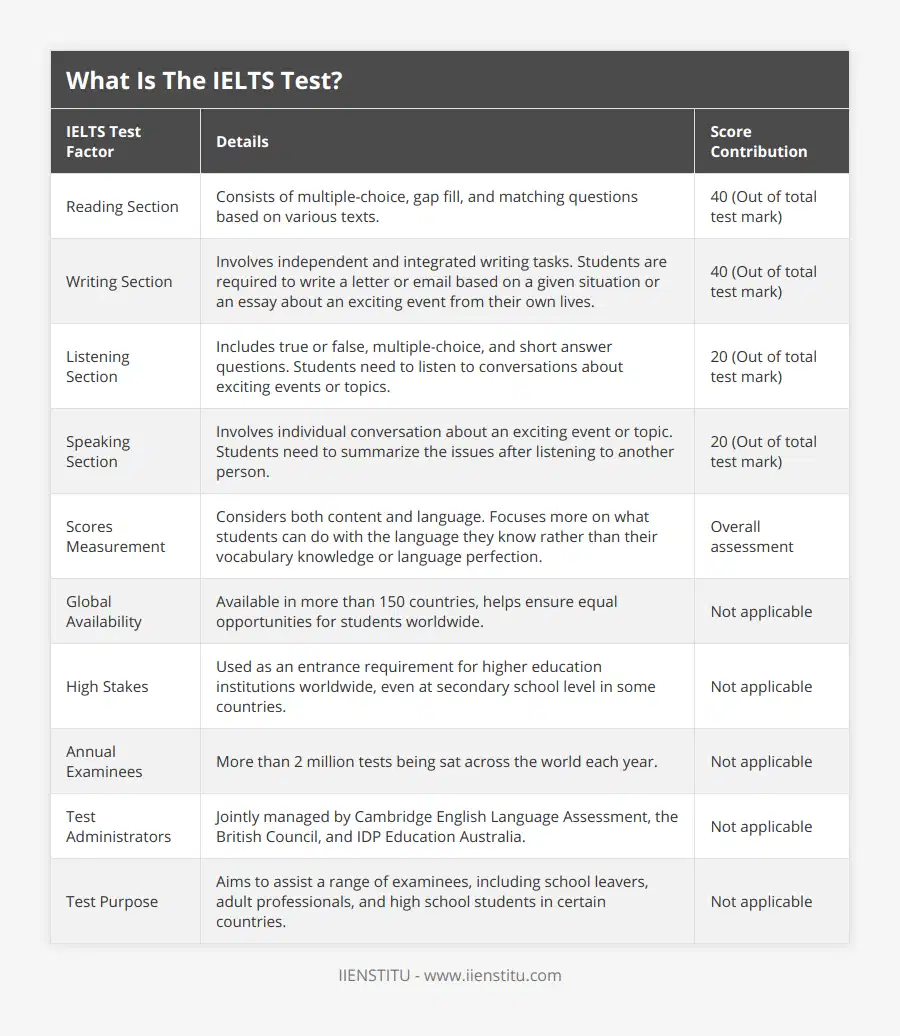
Frequently Asked Questions
What is the purpose of the IELTS test?
Purpose of the IELTS Test
Assessing Language Proficiency
The primary purpose of the International English Language Testing System (IELTS) is to accurately and objectively measure a candidate's English language proficiency. This renowned standardized test evaluates individuals in four key areas: listening, reading, writing, and speaking.
Global Acceptance
Additionally, IELTS serves as a critical requirement for immigration, education, and professional purposes across the globe. Various governments, universities, and employers recognize the test results as a reliable indicator of English language competence.
Tailoring to Individual Needs
Moreover, the IELTS test is designed to fulfill specific individual requirements by offering two versions: the IELTS Academic for individuals seeking higher education, and the IELTS General Training for those looking for work, migration, or vocational training opportunities.
Maintaining High Standards
Furthermore, the British Council, IDP: IELTS Australia, and Cambridge Assessment English jointly administer the IELTS to ensure a high level of expertise and consistency in test standard maintenance.
Facilitating an Effective Learning Process
Finally, preparing for the IELTS test provides candidates with an opportunity to enhance their overall English language abilities. By focusing on the four skill areas, individuals both improve their language proficiency and gain essential tools for their success in education, career, and migration pursuits.
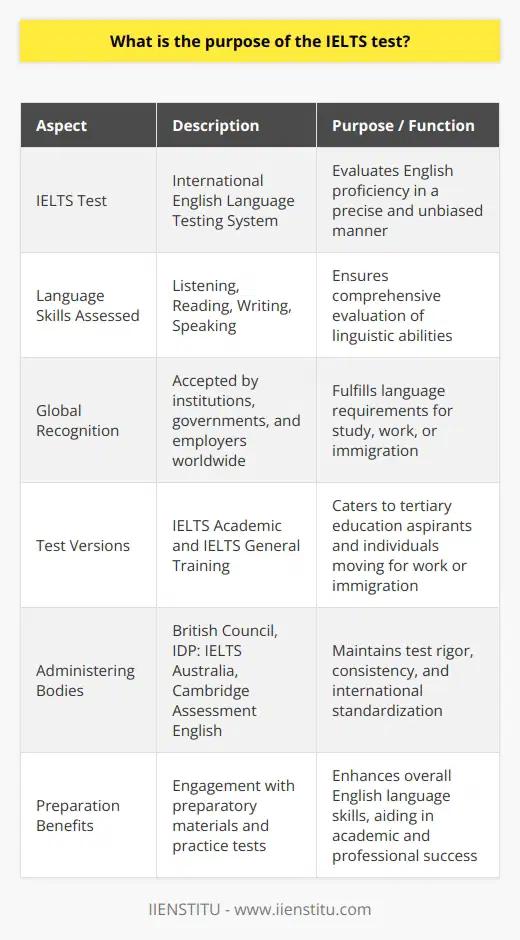
Is it difficult to pass IELTS?
IELTS Difficulty Level
The difficulty of passing the IELTS (International English Language Testing System) varies depending on a multitude of factors. It is important to recognize that the test assesses English proficiency across four core competencies: listening, reading, writing, and speaking. The overall challenge is highly dependent on an individual's language background, exposure to English, and their previous experience in taking standardized tests.
Language Background
For learners whose first language is linguistically distant from English, such as Chinese, Japanese, or Arabic speakers, the IELTS may pose a greater challenge compared to those with stronger linguistic ties to English, such as German or Dutch speakers. Moreover, individuals who have been conversing in and exposed to English on a regular basis are more likely to find the IELTS less challenging, as they have ample opportunities to practice their skills.
Test Preparation
Another key factor in determining the difficulty of the IELTS is the extent and quality of test preparation. Like any other standardized test, familiarizing oneself with the test format and question types is crucial for success. It is recommended to utilize readily available resources, such as practice tests, study guides, and workshops, to maximize one's chances of scoring well on the IELTS.
Academic vs. General Training
It is worth noting that there are two main versions of the IELTS: Academic and General Training. The Academic version is geared towards those applying to higher education institutions, whereas the General Training version is for immigration purposes or vocational training. The reading and writing sections of the Academic IELTS are considered more challenging than the General Training version due to their focus on complex, academic text and writing styles.
Personal Factors
In addition to the factors mentioned above, individual learning styles, personal motivation, and time investment all contribute to the overall IELTS difficulty. Some test takers may have a natural aptitude for language learning, while others may struggle with certain aspects of the test. Furthermore, having a clear goal and dedicating sufficient time to practice and study can greatly increase one's chances of achieving the desired IELTS score.
In conclusion, the difficulty of passing the IELTS is largely subjective and dependent on various factors, including language background, test preparation, the version of the test taken, and personal factors. To increase the likelihood of success, it is essential for individuals to familiarize themselves with the test format and engage in focused preparation and practice.
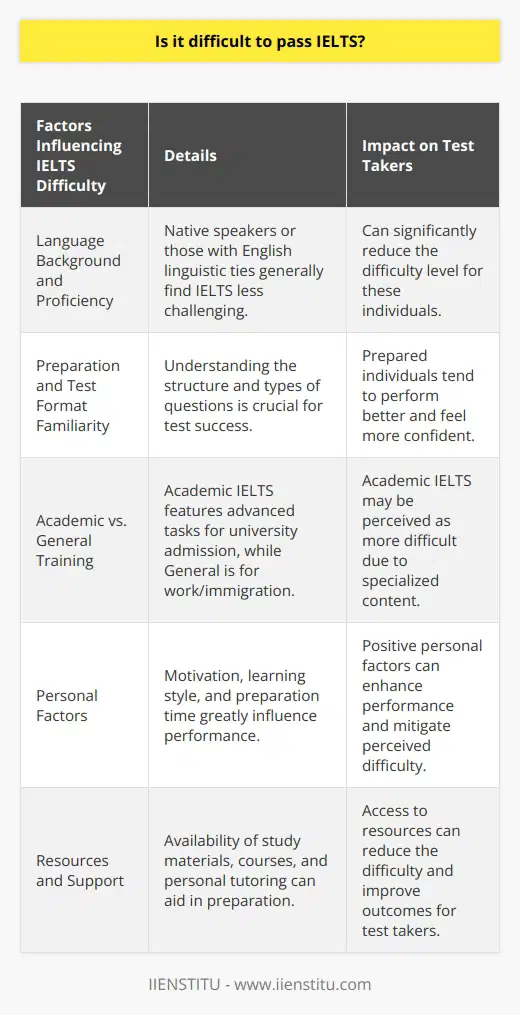
What does the IELTS exam consist of?
IELTS Exam Components
The International English Language Testing System (IELTS) evaluates an individual’s proficiency in English through four core components: listening, reading, writing, and speaking. Beneficial for those seeking work, education, or migration opportunities, the exam is recognized by numerous organizations worldwide.
Listening Section
The listening component features four recorded monologues and conversations, totaling approximately 30 minutes. Test-takers must answer a series of 40 questions based on the audio content, assessing their ability to understand main ideas and specific details within spoken language. They are only given one chance to listen to the recordings, requiring focus and attention.
Reading Section
The reading component consists of three long passages and 40 questions, with test-takers allotted 60 minutes to complete this segment. Passages differ depending on whether the Academic or General Training version of the IELTS is taken. Reading material for Academic IELTS mainly comprises complex, descriptive texts, while General Training focuses on functional, work-related language.
Writing Section
The IELTS writing section, also divided into Academic and General Training versions, demands test-takers to complete two tasks within 60 minutes. Academic participants analyze graphs or diagrams in Task 1 and present a well-structured argument on an assigned topic in Task 2. Conversely, General Training candidates must draft a letter for Task 1 and compose an essay expressing their personal opinion in Task 2.
Speaking Section
The speaking component is unique in that it resembles an actual conversation, where test-takers converse with a certified examiner for 11 to 14 minutes. Constituting three parts, it assesses an individual’s ability to express their opinion, discuss a topic, and provide detailed information. The examiner evaluates the examinee's syntax, pronunciation, and fluency.
Ultimately, the IELTS exam covers an extensive range of language skills, providing a comprehensive assessment of an individual’s English proficiency. Consequently, it serves as a reliable benchmark for educational institutions, employers, and immigration authorities.
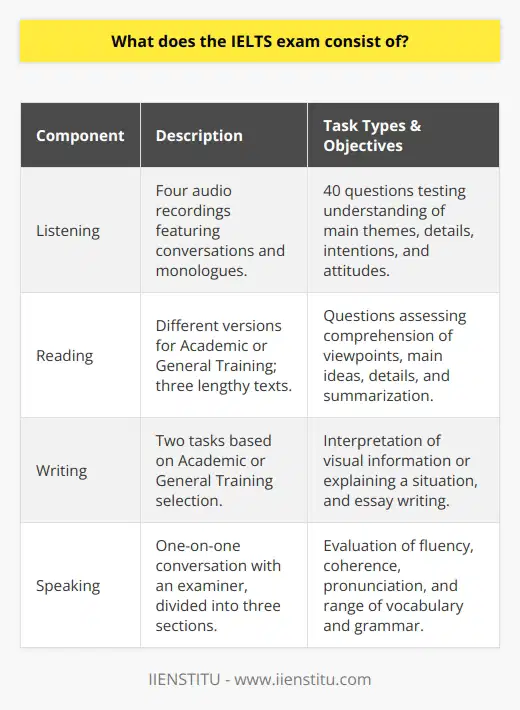
What is the passing score for IELTS?
IELTS Passing Score
The International English Language Testing System (IELTS) is designed to assess an individual's English language proficiency for academic, immigration, or professional purposes. The passing score depends on the specific requirements set by the institution or organization to which the individual is applying.
IELTS Scoring System
The IELTS test comprises four sections: Listening, Reading, Writing, and Speaking. The performance in each section is rated on a scale of 0 to 9, known as IELTS band scores. These individual band scores are then averaged to produce an overall score. The overall band score ranges from 1 (non-user) to 9 (expert user).
Requirement Variations
The passing score varies according to the goals of the test taker, the institution, or the country. For example, universities may require different overall and individual band scores for admission. A minimum IELTS score of 6.0 is often seen as acceptable for undergraduate programs, while a minimum score of 6.5 or even 7.0 may be required for postgraduate courses.
Immigration authorities may also determine their own minimum passing scores, depending on factors such as the individual's occupational needs and the level of English mastery expected for successful integration into the society.
Achieving the Target Score
To obtain the desired score in the IELTS test, it is crucial for test takers to prepare thoroughly by familiarizing themselves with the structure of the test, practicing specific sections, and working to improve their overall English language proficiency. Additionally, they should be aware of the specific band score requirements of their target institution, organization, or immigration authority in order to focus their efforts on meeting those thresholds.
To Sum Up
There is no universal passing score for the IELTS test, as it varies depending on the requirements of the institution or organization. Test takers should research the specific minimum score required by their target institution or immigration authority and gauge their ongoing progress using online tools and learning resources to prepare for the IELTS test and achieve the desired score.
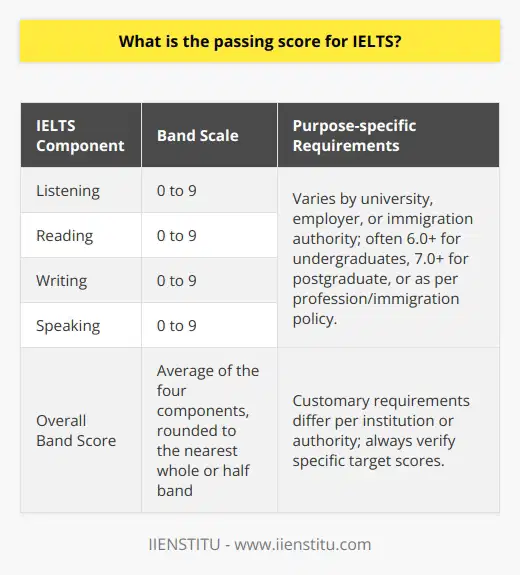
Is 7 a good score in IELTS?
Understanding IELTS Scores
In order to determine whether a score of 7 is considered good in the International English Language Testing System (IELTS) exam, it is essential to understand the IELTS scoring system. IELTS scores range from 1 to 9, with 9 representing the highest level of English proficiency.
Contextualizing the Score
A score of 7 indicates a competent user of English language. This means that the individual has a good command of the language, can use complex structures, and comprehend detailed instructions. However, minor misunderstandings or inaccuracies in language may still be present. Whether a score of 7 is considered good depends on several variables, such as the specific purpose of taking the exam, the required scores for academic institutions, or employers and individual growth.
Academic and Professional Requirements
For some universities or professional organizations, a score of 7 may be adequate to meet their minimum English language proficiency requirements. Generally speaking, top-ranking universities and competitive programs often have higher IELTS score requirements, such as 7.5 or 8. It is crucial to research the specific IELTS score requirements for the targeted academic institution or professional organization to determine if a score of 7 is deemed satisfactory.
Individual Progress
When considering personal development and the notion of 'good' scores, it is essential to assess individual progress. If an individual's previous scores were significantly lower, obtaining a score of 7 would be considered an achievement, demonstrating noticeable improvement in their English language skills. Likewise, if an individual's goal is to reach the competent user level (for personal or professional purposes), a score of 7 would be considered a good achievement.
Conclusion
Ultimately, whether an IELTS score of 7 is considered good depends on multiple factors, including the context, specific academic or professional requirements, and personal goals. A score of 7 represents a competent level of English and may be sufficient for some universities and professional organizations. However, it is crucial to research the required score for the desired institution or organization and continuously strive for personal development in order to reach higher levels of English proficiency.
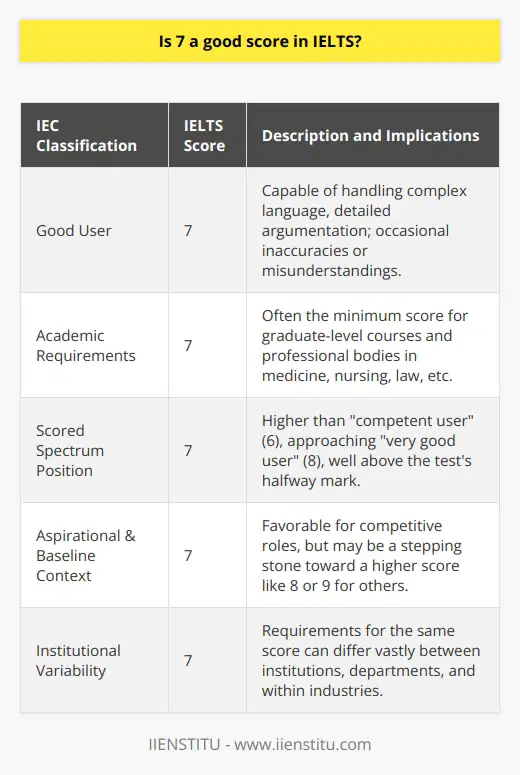
How do the IELTS scores correlate with language proficiency levels?
IELTS and Language Proficiency Levels
Understanding IELTS Scores
The International English Language Testing System (IELTS) is a prominent proficiency evaluation for non-native English speakers. It assesses linguistic competencies across four categories: listening, reading, writing, and speaking. The test results reflect an individual's skill in using the English language, with scores ranging from 0 to 9. These scores further correlate with various global language proficiency scales, including the Common European Framework of Reference (CEFR).
Correlation with CEFR Levels
The CEFR is a widely recognized standard for evaluating language skills. It consists of six levels, from A1 (beginner) to C2 (proficient), characterizing learners' capacity to comprehend and communicate in a new language. IELTS scores correspond to these CEFR levels, enabling a more comprehensive comparison between candidates' abilities.
Score Interpretation
Below is a brief outline of how IELTS scores align with the CEFR levels:
An IELTS score of 2 or lower corresponds to CEFR level A1 (breakthrough), denoting a basic ability to exchange simple information.
A score of 3 implies CEFR level A2 (waystage), reflecting a more extensive vocabulary and the ability to handle routine situations.
Scores of 4 to 4.5 align with CEFR level B1 (threshold), indicating a capacity to communicate essential thoughts using familiar contexts.
IELTS marks of 5 to 6.5 correspond to CEFR level B2 (vantage), denoting a competent command of English, with the potential for academic or professional success.
Scores of 7 to 8 demonstrate CEFR level C1 (effective operational proficiency), highlighting the advanced use of English, ideal for more complex academic and professional contexts.
Lastly, an IELTS score of 8.5 to 9 represents CEFR level C2 (mastery), showcasing a comprehensive grasp of the English language, similar to that of a highly-educated native speaker.
Conclusion
The correlation between IELTS scores and language proficiency levels facilitates a more nuanced understanding of an individual's English skills. This relationship allows universities, employers, and immigration authorities to make informed decisions, ensuring that candidates possess the necessary linguistic aptitude for various opportunities.
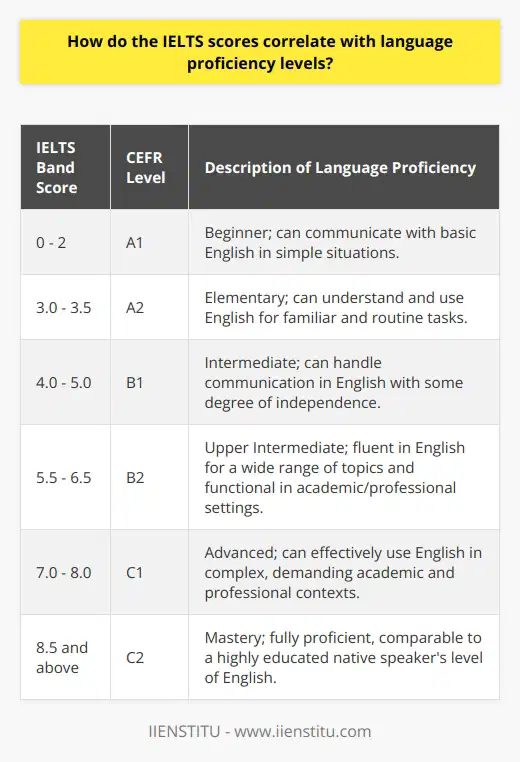
What factors influence the level of difficulty in IELTS?
Exam Structure and Design
A primary factor that influences the difficulty level of the International English Language Testing System (IELTS) is its exam structure and design. The IELTS is a rigorous test that assesses listening, reading, writing, and speaking skills in non-native English speakers.
Individual Language Proficiency
One's proficiency in the English language significantly affects the difficulty they experience in taking the IELTS. Test-takers with lower proficiency levels tend to face more challenges, while those with higher proficiency levels find the exam less daunting.
Test-Taking Strategies
Effective test-taking strategies can ease the difficulty of the IELTS. Preparing well and familiarizing oneself with the exam format, instructions, and types of questions can make a huge difference in a candidate's performance and overall score.
Quality of Learning Materials
Accessibility and quality of learning materials are essential for appropriate preparation. High-quality materials effectively help candidates to understand the test format, strategies, and potential challenges. Meanwhile, scarce or poorly designed resources may hinder sufficient preparation and lead to a more difficult experience during the exam.
Level of Anxiety and Stress
Psychological factors are also instrumental in the perception of the difficulty level of the IELTS. Candidates that exhibit higher levels of anxiety and stress may find the test more challenging, as these emotions can negatively impact performance.
Time Management Skills
A significant aspect of acing the IELTS is managing time effectively. The ability to answer questions quickly and efficiently influences the candidate's performance and the perceived level of difficulty. Those with poor time management skills may find the test more arduous.
In conclusion, various factors determine the difficulty level of the IELTS. Individual language proficiency, test-taking strategies, quality of learning materials, anxiety, stress, and time management skills significantly impact a candidate's ability to perform well in the exam. Achieving optimal performance requires consideration and attention to each of these factors.
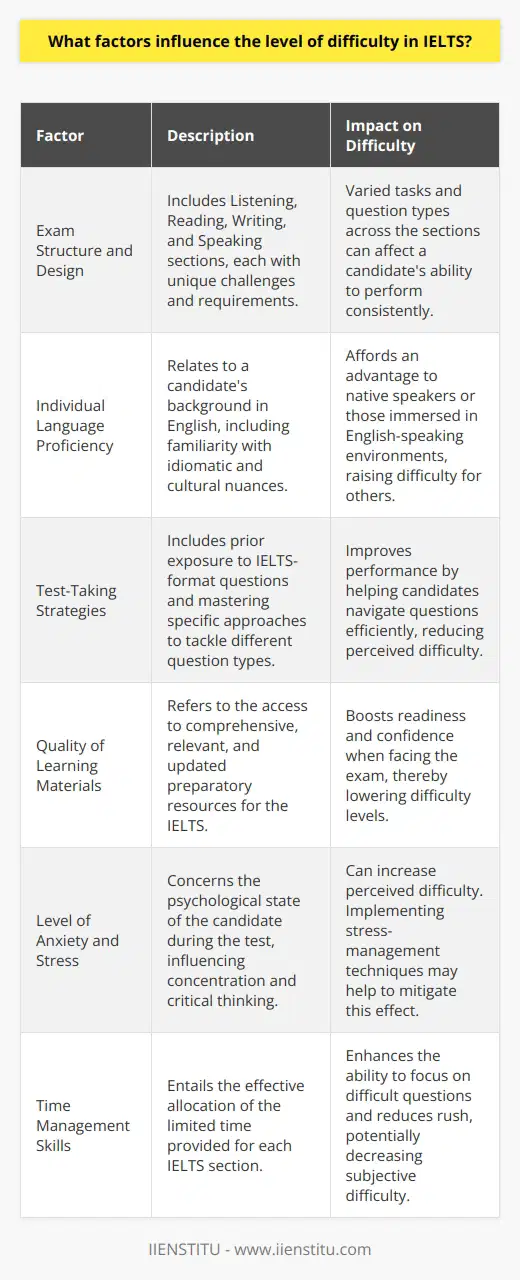
How can one determine if their IELTS score is sufficient for their intended purpose?
Determining the Adequacy of an IELTS Score
Assess University Requirements
Firstly, evaluate the specific requirements of the university or institution for the intended course of study. Many universities have minimum IELTS score requirements for each band, which must be met or exceeded to gain admission. For example, a university may require an IELTS score of 6.5 for undergraduate study or a 7.0 for postgraduate study.
Examine Visa Regulations
Secondly, check the visa requirements in the destination country. Some countries have specific IELTS score requirements for visa eligibility. For instance, the United Kingdom demands a minimum IELTS score for individuals applying for a Tier 4 student visa, which allows them to study in the country.
Consult Professional Associations
Thirdly, consult professional organizations relevant to the desired career. Certain occupations require a minimum IELTS score for professional registration or accreditation. Hence, verifying these requirements will help determine the adequacy of the IELTS score for the intended purpose.
Compare with Native English Speakers
Additionally, comparing one's IELTS score to native English speakers' scores can provide some perspective on its sufficiency. Generally, a native English speaker obtains an IELTS score between 7.0 and 9.0, indicating proficiency in the language. Thus, a score close to or within this range signifies a strong command of the English language.
Consider Immigration Points Systems
Lastly, investigate immigration points systems, if planning to immigrate to an English-speaking country. These systems frequently allocate points for language proficiency, including IELTS scores. An insufficient score could hinder the immigration process or make it more challenging to obtain permanent residency.
In summary, determining if an IELTS score is sufficient for one's intended purpose involves several factors such as university requirements, visa regulations, professional associations, benchmarking against native speakers, and immigration points systems. By examining these aspects, individuals can better understand the adequacy of their IELTS score and make informed decisions regarding their academic, professional, and personal goals.
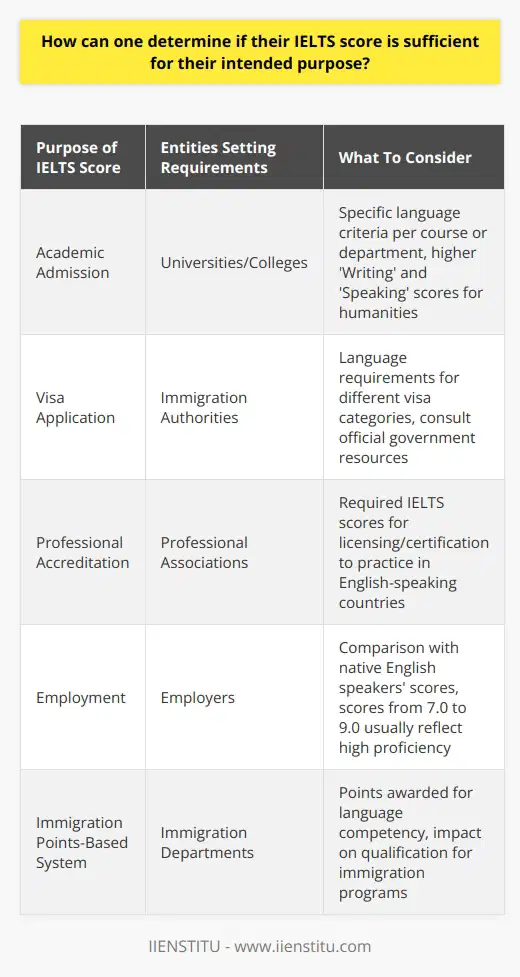
Are there any significant variations in the cost of taking the IELTS exam across different countries?
Significant Variations in Costs
Indeed, there are significant variations in the cost of taking the International English Language Testing System (IELTS) exam across different countries. These differences can be attributed to various factors, including exchange rates, government regulations, and the local cost of living.
Impact of Exchange Rates
One of the major reasons for the variation in IELTS exam fees across different countries is the fluctuating exchange rates. The test fee is set by individual test centers, based on their local currencies. For example, the fee might be lower in a country with a weaker currency, compared to a country with a stronger currency.
Government Regulations and Taxation
Another factor that can contribute to the variations in IELTS exam costs is government regulations and taxation. Some countries impose additional taxes or fees on educational services, which can increase the total cost of the test. In contrast, countries with lower taxes or subsidies for educational services may offer the exam at a more affordable rate.
Local Cost of Living
The local cost of living also plays a vital role in determining the cost of IELTS exam fees. Test centers operating in countries with a higher cost of living may charge more for the exam to cover overhead expenses, such as rent for the testing facility and staff salaries. On the other hand, test centers in countries with lower living costs may be able to offer the test at a reduced rate.
In conclusion, significant variations in the cost of taking the IELTS exam across different countries can be observed due to factors such as exchange rates, government regulations, and the local cost of living. As a result, prospective test-takers should research the fees in their local currency and consider these factors when selecting a test center to ensure they receive the best value for their investment in this crucial examination.
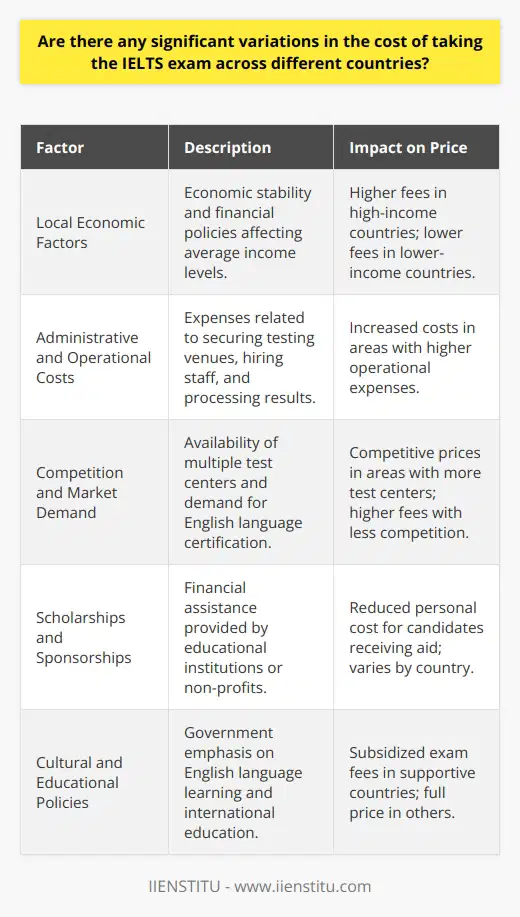
Is the IELTS exam widely accepted by institutions and organizations around the world?
**Global Acceptance of the IELTS Exam**
The IELTS exam, or International English Language Testing System, is indeed widely accepted by various institutions and organizations throughout the world as a reliable indicator of an individual's proficiency in the English language. It serves as a significant tool for educational establishments, employers, professional organizations, and immigration authorities in evaluating the applicants' English language skills.
**Educational Institutions**
Numerous universities in English-speaking countries, including the United States, United Kingdom, Australia, and Canada, rely on IELTS scores to gauge the language ability of potential students. Education providers often set minimum score requirements for applicants depending on the level and discipline of the program, ensuring international students can effectively participate in academic activities.
**Employment Opportunities**
In the global job market, IELTS has carved a niche for itself as a means of assessing the English competency of candidates vying for positions that demand strong linguistic skills. Many businesses, particularly those operating internationally, use the IELTS exam to ensure potential hires can communicate effectively in written and spoken English.
**Professional Organizations and Licensing Bodies**
For individuals seeking to join a professional organization, practice in a regulated profession, or obtain a professional license, IELTS scores are often submitted as proof of English proficiency. Professions that entail public dealings and distribution of information, such as healthcare, law, and engineering, frequently require a certain level of IELTS score to guarantee that practitioners can communicate effectively with clients and colleagues.
**Immigration Authorities**
English-speaking countries, such as Australia, Canada, New Zealand, and the United Kingdom, have incorporated the IELTS exam into their immigration and visa procedures. Accepting IELTS scores as evidence that visa applicants possess adequate language skills eases the immigration process. These countries typically set specific minimum scores, depending on the type of visa sought and the applicant's purpose of stay.
In conclusion, the IELTS exam has become an integral part of the international landscape, enjoying widespread acceptance across various domains. Its role in assessing English proficiency is valued by institutions and organizations across the globe, making it a crucial factor in determining an individual's ability to successfully navigate academic, professional, and social environments.
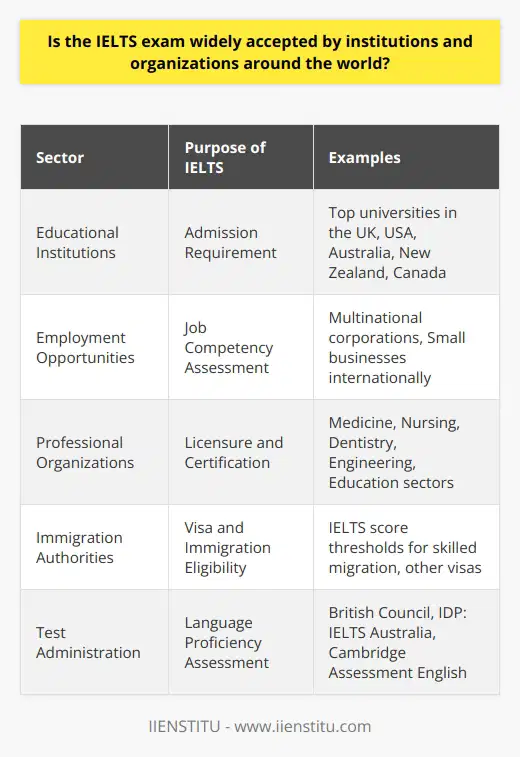
What can test-takers do to adequately prepare for the challenges of the IELTS examination?
Understanding the Test Format
To effectively prepare for the IELTS examination, test-takers must first familiarize themselves with the overall structure and format of the test. By understanding the various sections - listening, reading, writing, and speaking - as well as the specific question types, candidates can develop targeted strategies for each component of the exam.
Improving Language Skills
Next, it is essential for test-takers to continually work on enhancing their English language proficiency in order to succeed in the IELTS examination. Regular practice in reading, writing, speaking, and listening can significantly improve a candidate's language skills. Furthermore, engaging in activities such as reading English newspapers, participating in language exchanges, or joining English-speaking clubs can offer additional opportunities to develop language proficiency.
Building Test Strategies
Developing effective test-taking strategies is another crucial aspect of preparing for the IELTS examination. Candidates should practice time management techniques, as well as become proficient at quickly identifying main ideas and keywords in reading passages. Moreover, they can refine their listening abilities by practicing with English songs, podcasts, or videos, while simultaneously mastering note-taking techniques to capture essential information.
Utilizing Study Resources
Making use of available study resources, such as IELTS preparation books, online courses, and mobile applications, can assist test-takers in their preparation process. These materials often provide comprehensive content coverage, practice exercises, and tips to maximize test performance.
Seeking Feedback and Assistance
Lastly, seeking feedback from others, especially teachers or native English speakers, can help candidates identify their strengths and weaknesses and receive valuable insights on their performance. By heeding constructive advice and working diligently to address any areas of difficulty, test-takers can significantly improve their chances of achieving their desired IELTS scores.
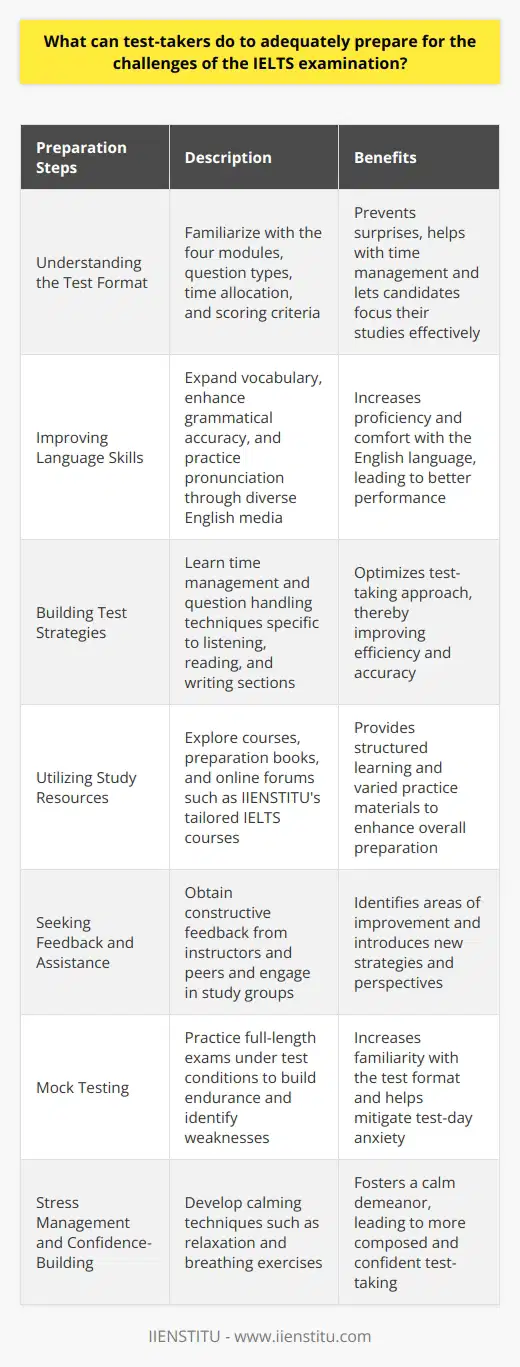
How often can an individual retake the IELTS exam if they want to improve their score?
Frequency of IELTS Exam Retakes
Individuals seeking to improve their IELTS scores have the flexibility to retake the exam as many times as they desire. There is no official limit on the number of attempts an individual can make.
Minimum Gap Between Attempts
However, it is essential to consider the minimum waiting period between consecutive attempts, which is 14 days. This gap ensures that examinees have ample time to prepare and work on their weaknesses before attempting the test again.
Impact on Scores
Taking frequent attempts at the IELTS exam might not guarantee improved scores. Thus, it is crucial to identify the areas requiring improvement and devise a strategic plan, incorporating quality study materials and professional guidance, to enhance performance.
Consideration for Institutions
On the other hand, academic institutions and other organizations might have specific policies regarding the number of IELTS attempts considered for admissions or other eligibility criteria. Candidates should research these policies to make informed decisions about their retakes.
Balancing Exam Costs
Another aspect to consider is the financial implications of retaking the IELTS exam multiple times. As each attempt incurs a fee, it is advisable to strike a balance between the desired result and financial investment by thoroughly preparing before each try.
In conclusion, while the IELTS exam can be retaken as many times as an individual desires, it is essential to evaluate various factors such as the waiting period, personal goals, institutional policies, and financial considerations. Intentional preparation and targeted improvements can help achieve the desired score and minimize the need for numerous retakes.
